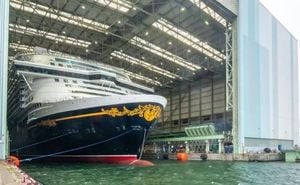Construction has officially commenced for Poland’s first offshore wind farm, the Baltic Power project, situated in the Baltic Sea. This landmark development, led by the ORLEN Group and Northland Power, marks a significant step forward in Poland’s renewable energy transition.
After months of careful preparation, 11 specialized vessels mobilized recently to begin installing the foundational structures known as monopiles. These towering steel structures, each reaching up to 100 meters tall, will support the advanced 15 MW wind turbines, with 78 monopiles planned to be installed in total.
The initial stages of construction have already seen the successful installation of the first two monopiles. The project is set to deliver substantial clean energy by 2026, with the capacity to power approximately 1.5 million households across Poland—demonstrated by its anticipated capacity of 1.2 GW.
“Our new strategy is about action and delivering tangible progress, as demonstrated by Poland’s first offshore wind farm. After months of intensive work, we are proud to confirm...,” stated Ireneusz Fąfara, President and CEO of ORLEN S.A., underscoring the project's significance not just for the ORLEN Group but for the broader Polish economy.
Offshore wind is now a key component of ORLEN Group’s ambitious strategy, which outlines plans for over 4 GW of installed capacity across the Baltic Sea. The Baltic Power project is the first and most advanced of these initiatives, laying the groundwork for additional offshore farms, for which licenses are already secured.
Building on its commitment to local industry, ORLEN is ensuring Polish companies are integral to the Baltic Power project’s success. Various components, such as turbine nacelles, subsea cables, and offshore substations, are being manufactured domestically, with significant contributions from facilities across Szczecin, Bydgoszcz, the Tri-City area, Żary, and Niemodlin.
Christine Healy, President and CEO of Northland Power, co-developer of the Baltic Power project, remarked, “The installation of the first foundations for Baltic Power is a tremendous moment... Safety remains our top priority throughout every stage...,” highlighting the collaborative spirit and safety measures prioritized throughout the project’s execution.
The area designated for the Baltic Power offshore construction spans about 130 square kilometers, comparable to the size of Poland’s city of Gdynia. Within this expansive zone, each monopile, weighing up to 1,700 tonnes and exceeding 9 meters in diameter, is being strategically driven deep beneath the seabed at depths of approximately 40 meters using sophisticated floating installation cranes.
Aside from the cranes, over ten specialized ships are actively involved in the construction process. This fleet includes support vessels, tugboats, personnel carriers, environmental monitoring vessels, and security patrols, all contributing to the comprehensive oversight conducted by the Baltic Power Offshore Coordination Centre, which tracks construction activities and maritime traffic continually.
Following the installation of monopiles, transition pieces will connect the foundations to the turbines, with subsequent steps involving the assembly of wind turbines, offshore substations, inter-array cables linking the turbines, and export cables transmitting the electricity produced back to shore.
The anticipated completion of all construction activities is projected for 2026. Upon its full operational launch, the Baltic Power offshore wind farm is expected to generate around 4,000 GWh of zero-emission electricity annually. This shift to renewable energy is pivotal, promising to reduce CO₂ emissions by approximately 2.8 million tonnes each year when compared to traditional power generation methods.
Overall, the Baltic Power project not only stands as Poland's inaugural offshore wind farm but also sets the stage for future investments and developments within the renewable energy sector, promising sustainable energy solutions and fostering growth within Polish industries. The construction today signifies not just progress across the energy sector but also contributions to Poland's broader climate goals, illustrating the country’s commitment to greener energy sources.



